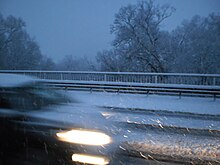Early winter



In meteorology, early winter is the early phase of winter , generally the period from late November / mid- December to early January .
Meteorologically, winter begins on December 1st for statistical reasons. The early winter begins with the proverbial " onset of winter ", the beginning of the closed snow cover or the beginning of permafrost ( icy days ) at the end of late autumn , which in Central Europe usually takes place in the last weeks of November to mid-December. The onset of winter has a particularly significant effect because the Martini summer is relatively frequent as a late autumn heat drop, and there are regularly noticeable temperature drops at the end of this. Towards the end of December, a singularity emerges in Europe's climate , the Christmas thaw . With this the early winter ends, and the high winter follows in January . In the 1940s, Hermann Flohn specified early winter (abbreviated as Wf) to be 14-25. December, which describes a regular, more stable high pressure situation and a decrease in precipitation. Winter beginning before December 1st is generally referred to as early, and those towards mid-December as late. Other authors then also defined a first and second early winter (Wf1,2), roughly in the interval November 27–12. December resp. 12-26 December, or pre-winter (Wv, Nov. 30 - Dec. 2), Nikolaustauwetter (Dec. 4/5), early winter (Dec. 17-21), but the subdivisions of the meteorological seasons are too delicate enforced, mostly they are too local, or are not significant enough with occurrence frequencies around 50%. In contrast to late winter , early winter shows itself to be quite diverse in weather conditions in Europe.
In folk traditions, the Advent season , with which field work comes to an end, marks the end of early winter, the Rauhnächte (December 21/22 to January 5/6) its end. An important lottery day at the beginning of early winter is Martini , November 11th, from which the forest work traditionally begins.
literature
- Peter Bissolli, Christian-Dietrich Schoenwiese: Calendar -related weather phenomena in a new light. In: Naturwissenschaftliche Rundschau , 44 (1991) 5, ISSN 0028-1050 , pp. 169-175
Individual evidence
- ↑ Hochwinter ( Memento of the original from September 9, 2011 in the Internet Archive ) Info: The archive link was inserted automatically and has not yet been checked. Please check the original and archive link according to the instructions and then remove this notice. . In: Wetterlexikon , wetter-suedtirol.net
- ↑ H. Flohn, P. Hess: Large weather singularities in the annual weather pattern of Central Europe (= statistical-synoptic investigations 2). In: Meteorological and Hydrological Service of the German Democratic Republic: Meteorologische Rundschau 2, 1949, pp. 258–263.
- ↑ e.g. in Meteorologische Rundschau 7, 1954, ( limited preview in the Google book search)
- ↑ Peter bite Olli: probability and statistical characteristics of the weather usually cases in the Federal Republic of Germany and West Berlin. Dissertation, Goethe University Frankfurt am Main, 1991.
- ↑ see Ernst Heyer: The consideration of severe winters in terms of weather conditions. In: Zs. F. Meteorol. 9, 1955, pp. 85-88, especially 86 f
